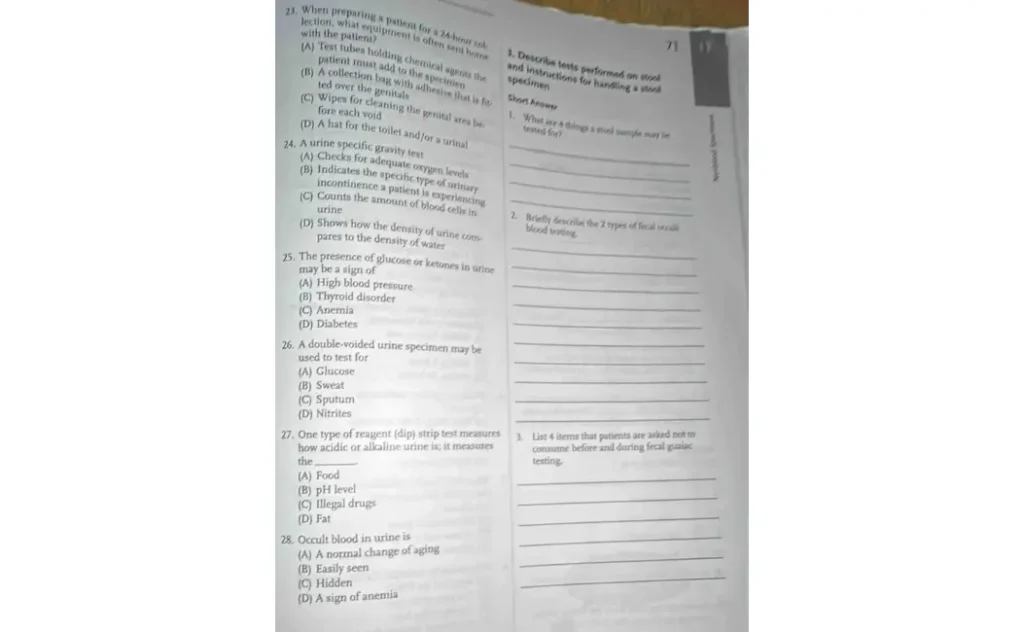Homework Help: Questions and Answers: When preparing a patient for a 24-hour collection what equipment is often sent home with patient?
(A) Test tubes holding chemical agents the specimen patient must add to the specimen and instructions for handling a stool
(B) A collection bag with adhesive that is fitted over the genitals
(C) Wipes for cleaning the genital area before each void.
(D) A hat for the toilet and/or a urinal

Step by step Answering
Question 1: When preparing a patient for a 24-hour collection, what equipment is often sent home with the patient?
(A) Test tubes holding chemical agents the specimen patient must add to the specimen and instructions for handling a stool
(B) A collection bag with adhesive that is fitted over the genitals
(C) Wipes for cleaning the genital area before each void.
(D) A hat for the toilet and/or a urinal
Correct Answer: (D) A hat for the toilet and/or a urinal
Explanation: When preparing for a 24-hour urine collection, patients are typically sent home with a “hat” for the toilet (a container that fits under the toilet seat) and/or a urinal for collecting urine. This equipment makes it easier for patients to collect and store all their urine over the 24-hour period.
Question 2: A urine specific gravity test
(A) Checks for adequate oxygen levels
(B) Indicates the specific type of urinary incontinence a patient is experiencing
(C) Counts the amount of blood cells in urine
(D) Shows how the density of urine compares to the density of water
Correct Answer: (D) Shows how the density of urine compares to the density of water
Explanation: A urine specific gravity test measures the concentration of urine by comparing its density to the density of water. It helps in assessing the kidney’s ability to concentrate or dilute urine.
Question 3: The presence of glucose or ketones in urine may be a sign of
(A) High blood pressure
(B) Thyroid disorder
(C) Anemia
(D) Diabetes
Correct Answer: (D) Diabetes
Explanation: The presence of glucose or ketones in urine is often associated with diabetes. Glucose in urine indicates that the blood sugar levels are high, and ketones appear when the body is breaking down fat for energy instead of glucose, which can happen in uncontrolled diabetes.
Question 4: A double-voided urine specimen may be used to test for
(A) Glucose
(B) Sweat
(C) Sputum
(D) Nitrites
Correct Answer: (A) Glucose
Explanation: A double-voided urine specimen involves emptying the bladder and then collecting urine again after a short time. This method is often used to test for glucose to get a more accurate reading of blood sugar levels.
Question 5: One type of reagent (dip) strip test measures how acidic or alkaline urine is; it measures the ________
(A) Food
(B) pH level
(C) Illegal drugs
(D) Fat
Correct Answer: (B) pH level
Explanation: A reagent strip (dipstick) test that measures how acidic or alkaline urine is checking the pH level. The pH level of urine can provide information about the body’s metabolic processes and kidney function.
Question 5: Occult blood in urine is
(A) A normal change of aging
(B) Easily seen
(C) Hidden
(D) A sign of anemia
Correct Answer: (C) Hidden
Explanation: Occult blood in urine refers to blood that is not visible to the naked eye but can be detected through testing. It may indicate various.
Learn More: Homework Help
Q. Which menu provides you options like Animation Scheme, custom Animation, Slide Transition?
Q. Which technology is primarily used in noise-canceling headphones to reduce unwanted ambient sounds?
Q. What is the primary function of a QR code generated by TEC-IT?
Q. What is the primary function of a physics engine in computer graphics and simulations?

